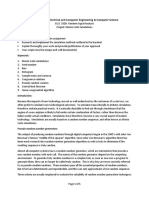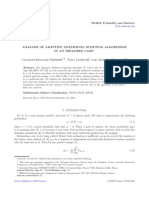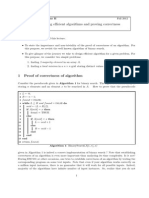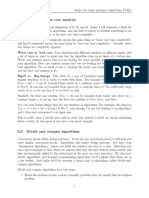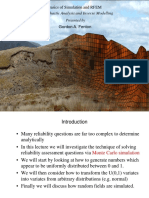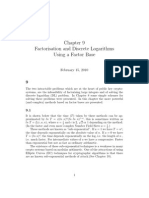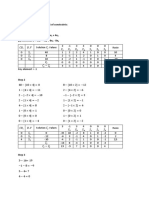0 ratings0% found this document useful (0 votes)
7 viewsProbab 10
Probab 10
Uploaded by
Sasi.b. Kumarclass notes
Copyright:
© All Rights Reserved
Available Formats
Download as PDF, TXT or read online from Scribd
Probab 10
Probab 10
Uploaded by
Sasi.b. Kumar0 ratings0% found this document useful (0 votes)
7 views3 pagesclass notes
Original Title
Probab10
Copyright
© © All Rights Reserved
Available Formats
PDF, TXT or read online from Scribd
Share this document
Did you find this document useful?
Is this content inappropriate?
class notes
Copyright:
© All Rights Reserved
Available Formats
Download as PDF, TXT or read online from Scribd
Download as pdf or txt
0 ratings0% found this document useful (0 votes)
7 views3 pagesProbab 10
Probab 10
Uploaded by
Sasi.b. Kumarclass notes
Copyright:
© All Rights Reserved
Available Formats
Download as PDF, TXT or read online from Scribd
Download as pdf or txt
You are on page 1of 3
Probabilistic/Randomized Algorithms If M is chosen to be a large, 31-bit prime, the period should be
significantly large for most applications. M = 2 31 - 1 = 2,147,483,647
and A = 48,271.
Ming- Hwa Wang, Ph.D.
COEN 279/AMTH 377 Design and Analysis of Algorithm s Same sequence occurs all the time for easy debugging, and input seed
Departm ent of Com puter Engineering (e.g., use system clock) for real runs.
Santa Clara Univ ersity Usually a random real number in the open interval (0,1), which can be
done by dividing by M.
Probabilistic or Random ized algorithm Multiplication overflow prevention: let Q = M / A = 44,488 and R = M %
At least once during the algorithm, a random number is used to make a A = 3,399,
decision instead of spending time to work out which alternative is best. xi+1 = Axi % M = A(xi % Q) - R(xi / Q) + M (xi), where (xi) = xi / Q -
The worst-case running time of a randomized algorithm is almost always Axi / M = 1 iff the remaining terms evaluate to less than zero, 0
the same as the worst-case running time of the non-randomized otherwise.
algorithm. xi+1 = Axi % M = Axi - M(Axi / M) = Axi - M(xi / Q) + M(xi / Q) - M(Axi
A good randomized algorithm has no bad input, but only bad random / M) = Axi - M(xi / Q) + M(xi / Q - Axi / M) = A(Q(xi / Q) + xi % Q) -
numbers. M(xi / Q) + M(xi / Q - Axi / M) = (AQ - M)(xi / Q) + A(xi % Q) + M(xi
The random numbers are important, and we can get an expected running / Q - Axi / M) = -R(xi / Q) + A(xi % Q) + M(xi / Q - Axi / M) = A(xi %
time, where we now average over all possible random numbers instead Q) - R(xi / Q) + M (xi)
of over all possible inputs, or the mean time that it would take to solve
the same instance over and over again. Num erical Probabilistic Algorithm s
A randomized algorithm runs quickly but occasionally makes an error. For certain real-life problems, computation of an exact solution is not
The probability of error can, however, be make negligibly small. Any possible even in principle, e.g., uncertainties in the experimental data, digital
purported solution can be verified efficiently for correctness. computers handle only binary values, etc. For other problems, a pre cise
A randomized algorithm may give probabilistic answers which are not answer exists but it would take too long to figure it out exactly. Numerical
necessarily exact. algorithms yield a confidence interval, and the expected precision improves
The same algorithm may behave differently when it is applied twice to as the time available to the algorithm increase. The error is usually inversely
the same instance. Its execution time, and even the result obtained, may proportional to the square root of the amount of work performed.
vary considerable from one use to the next. If the algorithm gets stuck Buffon’s Needle: throw a needle at random on a floor made of planks of
(e.g., core dump), simply restart it on the same instance for a fresh constant width, if the needle is exactly half as long as the planks in the
chance of success. If there is more than one correct answer, several floor and if the width of the cracks between the planks are zero, the
different ones may be obtained by running the probabilistic algorithm probability that the needle will fall across a crack is 1/ . The probability
more than once. that a randomly thrown needle will fall across a crack is 2 / , where is
An expected running time bound is somewhat stronger than an average - needle length and is plank width. The result estimate will be between
case bound, but is weaker than the corresponding worst-case bound. and with probability at least (desired reliability).
Numerical integration - Monte Carlo integration: deterministic integration
Random Num ber Generators algorithms are easy to be fooled, and very expensive when evaluating a
True randomness is virtually impossible to do on a computer. multiple integral. The hybrid techniques that partly systematic and partly
Pseudorandom numbers. What really needed is a sequence of random probabilistic is called quasi Monte Carlo integration.
numbers appear independently. Probabilistic Counting:
The linear congruential generator: xi+1 = Axi % M, where x0 is the seed Counting twice as far to up to 2 n+1 - 2 by initialize to 0, each time
and 1 ≤ x0 < M. If M is prime, xi is never 0. After M-1 numbers, the tick is called, flip a fair coin. If it comes up head, add 1 to the
sequence repeat (period of M-1). Some choices of A gets shorter period register, otherwise, do nothing. When count is called, return twice
than M-1. the value stored in the register.
Counting exponentially farther from 0 to 22 n-1 - 1. Keep in the Skip Lists
register an estimate of the logarithm of the actual number of ticks Every 2 ith node has a pointer to the node 2 i ahead of it. The total
and count(c) returns 2 c-1. Keep the relative error in control instead number of pointers has only doubled, but now at most lgN nodes
of absolute. are examined during a search. The search consists of either
advancing to a new node or dropping to a lower pointer in the same
Monte Carlo Algorithm s node.
Monte Carlo algorithms give exact answer with high probability whatever the A level k node is a node that has k pointers, the ith pointer in any
instance considered, although sometimes they provide a wrong answer. level k node (k i) points to the next node with at least i levels.
Generally you cannot tell if the answer is correct, but you can reduce the Roughly half the nodes are level 1 nodes, roughly a quarter are level
error probability arbitrarily by allowing the algorithm more time (amplifying 2, and, in general, approximately 1/2 i nodes are level i. We choose
the stochastic). A Monte Carlo algorithm is p-correct if it returns a correct the level randomly.
answer with probability at least p (0 < p < 1), whatever the instance Find: start at the highest pointer at the header, traverse along this
considered. p depends on the instance size but not on the instance itself. level until find that the next node is larger than the one we are
Verifying Matrix Multiplication: looking for (or nil). When this occurs, go to the next lower level and
straightforward matrix multiplication algorithm (n 3), Strassen’s continue the strategy. When progress is stopped at level 1, either we
algorithm (n 2.37) are in front of the node we are looking for, or it is not in the list.
Let D = AB - C, S {1,2, .., n}, and S(D) denote the vector of Insert: proceed as in a Find, and keep track of each point where we
length n obtained by adding pointwise the rows of D indexed by the switch to a lower level. The new node, whose level is determined
elements of S. S(D) is always 0 if AB equal C, otherwise, assume i randomly, is then spliced into the list.
be an integer such that the ith row of D contains at least one nonzero O(lgN) expected cost
element. The probability that S(D) 0 is at least one-half. Let X be a Skip lists need an estimate of the number of elements that will be in
binary vector of length of n such that Xj = 1 if j S and Xj = 0 the list to determine the number of levels. Different level of nodes
otherwise. Then S(D) = XD, and we want to verify if XAB = XC, need different type declarations.
where (XA)B need (n 2). Getting the answer false just once allows
you conclude that AB C. The probability that k successive calls each Las Vegas Algorithm s
-k -k
return the wrong answer is at most 2 , so it is (1 - 2 ) correct. Las Vegas algorithms make probabilistic choices to help guide them more
Alternatively, Monte Carlo algorithms can be given an explicit upper quickly to a correct solution, they never return a wrong answer. Two main
bound on the tolerable error probability in (n 2lg -1). categories of Las Vegas algorithms: it take longer time to solve a problem
Primality Testing when unfortunate choice are made (e.g., Quicksort), and alternatively, they
O(2 d/2) to test whether a d-digit number is a prime allow themselves go to a dead end and admit that they cannot find a solution
Randomized polynomial-time algorithm: if the algorithm declares in this run of the algorithm. A Las Vegas algorithm has the Robin Hood
that the number is not prime, then it is certainly not a prime. If the effect, with high probability, instances that took a long time deterministically
algorithm declares that the number is a prime, then with high are now solved much faster, but instances on which the deterministic
probability but not 100% sure, the number is prime. algorithm was particularly good are slowed down to average. Let p(x) be the
Fermat's Lesser Theorem: If P is prime, and 0 < A < P, then AP-1 1 probability of success of the algorithm, then the expected time t(x) is 1/p(x).
%P However, a correct analysis must consider separately the expected time
Pick 1 < A < N-1 at random. If AN-1 1 % N, declare that N is taken by LV(x) in case of success s(x) and in case of failure f(x). t(x) = s(x)
probably prime, otherwise declare that N is definitely not prime. + ((1-p(x))/p(x))f(x).
False witness of primality: Carmichael numbers are not prime but The Eight Queens Problem
satisfy AN-1 1 % N for all 0 < A < N that are relatively prime to N. Combine backtracking with probabilistic algorithm, first places a
If P is prime and 0 < X < P, the only solutions to X2 = 1 % P are X = number of queens on the board in a random way, and then uses
1, P-1. backtracking to try and add the remaining queens without
reconsidering the positions of the queens that were placed randomly.
The more queens we place randomly, the smaller the average time
needed by the subsequent backtracking stage, whether it fails or
succeeds, but the greater the probability of failure. This is the fine -
tuning knob.
Probabilistic Quickselect and Quicksort
Universal Hashing
Las Vegas hashing allows us to retain the efficiency of hashing on the
average, without arbitrarily favoring some programs at the expense
of others. Choose the hash function randomly at the beginning of
each compilation and again whenever rehashing becomes necessary,
ensure that collision lists remain reasonably well-balanced with high
probability.
Universal hashing: Let U = {1,2, .., a-1} be the universe of potential
indexes for the associative table, and let B = {1,2, ..,N-1} be the set
of indexes in the hash table. Let two distinct x and y in U, a set H of
functions from U to B, and h:U B is a function chosen randomly
from H, H is a universal2 class of hash functions if the probability that
h(x) = h(y) is at most 1/N. Let p be a prime number at least as large
as a, and i, j be two integers (1 i < p and 0 j < p), then h ij(x) =
((ix + j)%p)%N, and H is universal2.
Factorizing Large Integers
The factorization problem consists of finding the unique
decomposition of n into a product of prime facto rs. The splitting
consists of finding one nontrivial divisor of n, provided n is
composite. Factorizing reduces to splitting and primality testing. An
integer is k-smooth if all its prime divisors are among the k smallest
prime numbers. k-smooth integers can be factorized efficiently by
trial division if k is small. A hard composite number is the product of
two primes of roughly equal size.
Let n be a composite integer, Let a and b be distinct integers
between 1 and n-1 such that a + b n. If a2 % n b2 % n, then
gcd(a+b, n) is a nontrivial divisor of n.
You might also like
- Computational ComplexityDocument5 pagesComputational ComplexityShreyash BadoleNo ratings yet
- Math 243M, Numerical Linear Algebra Lecture NotesDocument71 pagesMath 243M, Numerical Linear Algebra Lecture NotesRonaldNo ratings yet
- RandomizedDocument11 pagesRandomizedRAJENDRANNo ratings yet
- Blaeser Algorithms and Data StructuresDocument109 pagesBlaeser Algorithms and Data StructuresMaia OsadzeNo ratings yet
- Nbs VonneumannDocument3 pagesNbs VonneumannRishav DhungelNo ratings yet
- 161 MainDocument51 pages161 Mainmyturtle game01No ratings yet
- Generating Random NumbersDocument32 pagesGenerating Random NumbersEman ShahidNo ratings yet
- Randomized Algorithms: Methods and Techniques: Kuldeep Sharma Dr. Deepak GargDocument4 pagesRandomized Algorithms: Methods and Techniques: Kuldeep Sharma Dr. Deepak GargAgus HerawanNo ratings yet
- 1 What Is A Randomized Algorithm?: Lecture Notes CS:5360 Randomized AlgorithmsDocument8 pages1 What Is A Randomized Algorithm?: Lecture Notes CS:5360 Randomized AlgorithmsMirza AbdullaNo ratings yet
- Basic of Algorithms Analysis: Computational TractabilityDocument4 pagesBasic of Algorithms Analysis: Computational TractabilityMengistu KetemaNo ratings yet
- Random Project 222Document5 pagesRandom Project 222crkriskyNo ratings yet
- Treaps, Verification, and String MatchingDocument6 pagesTreaps, Verification, and String MatchingGeanina BalanNo ratings yet
- Randomized Algorithms: CPSC 335Document20 pagesRandomized Algorithms: CPSC 335Vivekanandhan VijayanNo ratings yet
- ClassLectures Numerical MethodsDocument84 pagesClassLectures Numerical MethodsFaisal Baig50% (2)
- NOTESDocument57 pagesNOTES3200764No ratings yet
- BréhierEtal 2015Document34 pagesBréhierEtal 2015ossama123456No ratings yet
- Lecture 5Document13 pagesLecture 5kostas_ntougias5453No ratings yet
- Lecture 4 CS210 2012 PDFDocument4 pagesLecture 4 CS210 2012 PDFMoazzam HussainNo ratings yet
- Factorization Reduced To Order FindingDocument4 pagesFactorization Reduced To Order FindingavnishNo ratings yet
- Introduction To Randomized AlgorithmsDocument18 pagesIntroduction To Randomized Algorithms6612Anshu madhamshetty AnshuNo ratings yet
- Objective: Lesson 1Document3 pagesObjective: Lesson 1Anil SainiNo ratings yet
- Bruteforce ExhaustiveSearchDocument55 pagesBruteforce ExhaustiveSearchMd. Abdul MukitNo ratings yet
- Factoring NBDocument6 pagesFactoring NBmattvatrasNo ratings yet
- Lecture 6Document9 pagesLecture 6Sasi.b. KumarNo ratings yet
- X (-5:.01:3) PlotDocument1 pageX (-5:.01:3) PlotclaudyaneNo ratings yet
- Measure of Randomness for Stochastic ProcessesDocument49 pagesMeasure of Randomness for Stochastic ProcessesliaoendymionNo ratings yet
- Basic Derandomization TechniquesDocument18 pagesBasic Derandomization TechniquesronalduckNo ratings yet
- Notes On NP Completeness: Rich Schwartz November 10, 2013Document18 pagesNotes On NP Completeness: Rich Schwartz November 10, 2013Sam ShoukatNo ratings yet
- AlgorithmDocument20 pagesAlgorithmSayantani KarmakarNo ratings yet
- Introduction To Quasi Random Numbers PDFDocument5 pagesIntroduction To Quasi Random Numbers PDFGabriel Nunes da SilvaNo ratings yet
- A Reliable Randomized Algorithm For The Closest-Pair ProblemDocument33 pagesA Reliable Randomized Algorithm For The Closest-Pair ProblemkletomzNo ratings yet
- Applied and Computational Harmonic Analysis: Emmanuel J. Candès, Mark A. DavenportDocument7 pagesApplied and Computational Harmonic Analysis: Emmanuel J. Candès, Mark A. DavenportCatalin TomaNo ratings yet
- Condition NumberDocument4 pagesCondition NumberDeep JoshiNo ratings yet
- Experiment No. 1: Objective: Write A MATLAB Program To Generate An Exponential Sequence X (N) (A)Document53 pagesExperiment No. 1: Objective: Write A MATLAB Program To Generate An Exponential Sequence X (N) (A)Shinibali MandalNo ratings yet
- With A Between 3 and 1+ 6 3.449, From Almost All Initial Conditions X Will Approach Permanent Oscillations Between Two ValuesDocument2 pagesWith A Between 3 and 1+ 6 3.449, From Almost All Initial Conditions X Will Approach Permanent Oscillations Between Two ValuesShubham ChandraNo ratings yet
- 0.1 Worst and Best Case AnalysisDocument6 pages0.1 Worst and Best Case Analysisshashank dwivediNo ratings yet
- NLAFull Notes 22Document59 pagesNLAFull Notes 22forspamreceivalNo ratings yet
- Basic Techniques For Design and Analysis of AlgorithmsDocument3 pagesBasic Techniques For Design and Analysis of AlgorithmsHernan SepulvedaNo ratings yet
- The Similarities and Differences Between Polynomials and IntegersDocument23 pagesThe Similarities and Differences Between Polynomials and IntegersGrant AtoyanNo ratings yet
- Glouwie Mae Nachon Exercise 1Document6 pagesGlouwie Mae Nachon Exercise 1Elmer Comares ValenzuelaNo ratings yet
- Quantum Computing: Subhashis Banerjee Department of Computer Science and Engineering IIT DelhiDocument28 pagesQuantum Computing: Subhashis Banerjee Department of Computer Science and Engineering IIT Delhicharles luisNo ratings yet
- BernsteinVazirani 23100071 FinDocument21 pagesBernsteinVazirani 23100071 FinHoney DasNo ratings yet
- Statistical MechanicsDocument6 pagesStatistical Mechanicsm sriNo ratings yet
- Computing A Glimpse of RandomnessDocument16 pagesComputing A Glimpse of RandomnessRyan SullenbergerNo ratings yet
- Karp RabinDocument2 pagesKarp RabinRobert WilliamsonNo ratings yet
- Lower Bounds in Computer ScienceDocument38 pagesLower Bounds in Computer ScienceMirza AbdullaNo ratings yet
- Cs 161 Lecture 04Document6 pagesCs 161 Lecture 04divyatamboli08No ratings yet
- Basic PRAM Algorithm Design TechniquesDocument13 pagesBasic PRAM Algorithm Design TechniquessandeeproseNo ratings yet
- A Rigorous Extension of The SCH Onhage-Strassen Integer Multiplication Algorithm Using Complex Interval ArithmeticDocument9 pagesA Rigorous Extension of The SCH Onhage-Strassen Integer Multiplication Algorithm Using Complex Interval ArithmeticQuyền NguyễnNo ratings yet
- 07 Fenton SimulationDocument52 pages07 Fenton SimulationAndres Pino100% (2)
- FinalDocument5 pagesFinalBeyond WuNo ratings yet
- Lec 7 WriteupDocument3 pagesLec 7 WriteupSake AnilaNo ratings yet
- Low-Degree Phase Transitions For Detecting A Planted Clique in Sublinear TimeDocument23 pagesLow-Degree Phase Transitions For Detecting A Planted Clique in Sublinear TimeJohn PeterNo ratings yet
- ps2Document3 pagesps2sunshiyao0No ratings yet
- Chapter 9 Factorising and DL Using A Factor BaseDocument11 pagesChapter 9 Factorising and DL Using A Factor Base2eaa889cNo ratings yet
- Ad3351 Daa Ass-II QB Edited 8.11.2024Document76 pagesAd3351 Daa Ass-II QB Edited 8.11.2024Tamil KNo ratings yet
- Empirical Finance7Document30 pagesEmpirical Finance7edison6685No ratings yet
- Chapter 1 - Introduction To Numerical Methods and AnalysisDocument9 pagesChapter 1 - Introduction To Numerical Methods and AnalysisRyan A. RamosNo ratings yet
- A-level Maths Revision: Cheeky Revision ShortcutsFrom EverandA-level Maths Revision: Cheeky Revision ShortcutsRating: 3.5 out of 5 stars3.5/5 (8)
- 58824567Document27 pages58824567Sasi.b. KumarNo ratings yet
- Daa Ia - 1 Test Mark Mca DeptDocument2 pagesDaa Ia - 1 Test Mark Mca DeptSasi.b. KumarNo ratings yet
- Web QPDocument3 pagesWeb QPSasi.b. KumarNo ratings yet
- We Are Intechopen, The World'S Leading Publisher of Open Access Books Built by Scientists, For ScientistsDocument13 pagesWe Are Intechopen, The World'S Leading Publisher of Open Access Books Built by Scientists, For ScientistsSasi.b. KumarNo ratings yet
- SoalDocument3 pagesSoalMuhammad FarhanNo ratings yet
- Machine Learning Course BrochureDocument5 pagesMachine Learning Course Brochureprashant18coffeeNo ratings yet
- CLASS X HOME ASSIGNMENT 2 (Ch-2)Document4 pagesCLASS X HOME ASSIGNMENT 2 (Ch-2)Tech armaanzNo ratings yet
- Interpolation With Higher Order Polynomials Is Prone To The Runge PhenomenonDocument34 pagesInterpolation With Higher Order Polynomials Is Prone To The Runge Phenomenonsirj0_hnNo ratings yet
- Fast Fourier TransformDocument32 pagesFast Fourier Transformanant_nimkar9243100% (3)
- Assignment 1 - DFTDocument3 pagesAssignment 1 - DFTSanthoshi KNo ratings yet
- Pre LSTM Intent ClassificationDocument11 pagesPre LSTM Intent ClassificationDennis Min ZengNo ratings yet
- KD Kakuro 5x5 v3 s2 b007Document3 pagesKD Kakuro 5x5 v3 s2 b007RADU GABINo ratings yet
- Roll No. ...................... Total Pages: 3: GSM/D-21Document3 pagesRoll No. ...................... Total Pages: 3: GSM/D-21Pankaj KaushikNo ratings yet
- Mathematics 9 Summative Test 1 Quarter: Ax BX +C 0Document2 pagesMathematics 9 Summative Test 1 Quarter: Ax BX +C 0Marvin CarilloNo ratings yet
- ICTCM21 Proceedings Aslam VillanuevaDocument8 pagesICTCM21 Proceedings Aslam VillanuevaEmco MillerNo ratings yet
- Experiment No 9: Problem Using Lagrange's MethodDocument4 pagesExperiment No 9: Problem Using Lagrange's Methodamol maliNo ratings yet
- Analysis and Complexity of AlgorithmsDocument13 pagesAnalysis and Complexity of Algorithmsmourya1990No ratings yet
- Chapter Two Part V Duality and Sensitivity AnalysisDocument75 pagesChapter Two Part V Duality and Sensitivity AnalysisGetahun GebruNo ratings yet
- Lesson 3.6 - Supervised Learning Neural Networks PDFDocument97 pagesLesson 3.6 - Supervised Learning Neural Networks PDFTayyaba FaisalNo ratings yet
- CCATPREPARATION AI Module 3Document13 pagesCCATPREPARATION AI Module 3Vaishnavi GuravNo ratings yet
- Polynomial FunctionsDocument81 pagesPolynomial FunctionsJessica CagbabanuaNo ratings yet
- Solution: For This Data, We Have The Forward Difference Difference TableDocument7 pagesSolution: For This Data, We Have The Forward Difference Difference TableSharal SaldanhaNo ratings yet
- Tarea 2 - Solución de Modelos de Programación Lineal de DecisiónDocument9 pagesTarea 2 - Solución de Modelos de Programación Lineal de DecisiónMaria OrozcoNo ratings yet
- On The Minimum Common Integer Partition Problem: Author: Xin Chen, Lan Liu, Zheng Liu, Tao Jiang Presenter: Lan LiuDocument29 pagesOn The Minimum Common Integer Partition Problem: Author: Xin Chen, Lan Liu, Zheng Liu, Tao Jiang Presenter: Lan LiuSudha RaniNo ratings yet
- Job Sequencing With Deadline: Unit 3 Greedy MethodsDocument24 pagesJob Sequencing With Deadline: Unit 3 Greedy MethodssejalNo ratings yet
- Simulated AnnealingDocument21 pagesSimulated Annealingwohaja9323No ratings yet
- NumericalAnalysisChapter2 28 02 23Document62 pagesNumericalAnalysisChapter2 28 02 23Rathea UTHNo ratings yet
- Lecture 3-Linear-Regression-Part2Document45 pagesLecture 3-Linear-Regression-Part2Nada ShaabanNo ratings yet
- 10 1 1 672 7118 PDFDocument35 pages10 1 1 672 7118 PDFkhikuNo ratings yet
- Outliers and Influential PointsDocument14 pagesOutliers and Influential PointsFazlur RahmanNo ratings yet
- Batch NormalisationDocument17 pagesBatch Normalisation4H5 VISHESH PETWALNo ratings yet
- cs6704 RMT Model A5 PDFDocument2 pagescs6704 RMT Model A5 PDFthanamNo ratings yet
- Gauss Elimination, Gauss-Jordan Elimination and Gauss Seidel Iteration Method: Performance Comparison Using Mat LabDocument11 pagesGauss Elimination, Gauss-Jordan Elimination and Gauss Seidel Iteration Method: Performance Comparison Using Mat LabJohan TobingNo ratings yet
- Chapter Two: Solution of Non-Linear EquationDocument30 pagesChapter Two: Solution of Non-Linear EquationFITSUM BirukNo ratings yet










